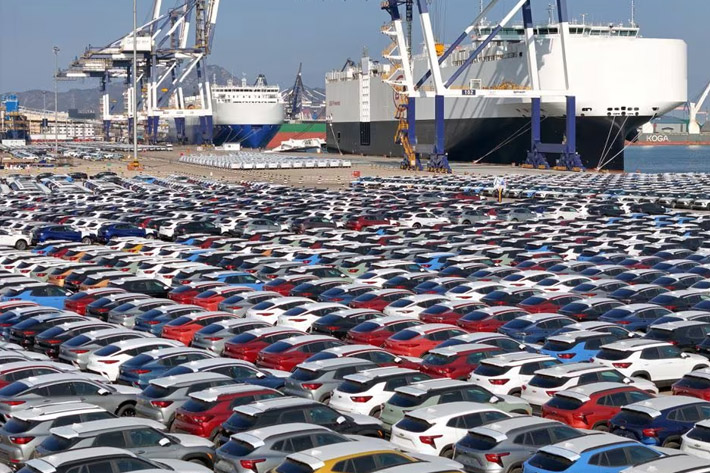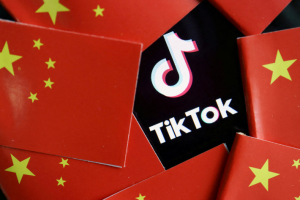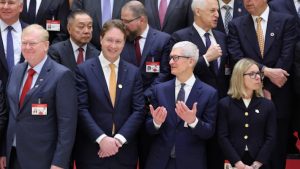Chinese companies have ordered nearly four dozens ships, to add to its record number of car-carrying vessels to support its boom in EV exports.
Carmakers and shippers have put the country on course to have the world’s fourth-largest fleet within four years.
China currently has the world’s eighth-largest fleet with 33 car-carrying ships, according to data from shipping consultancy Veson Nautical. At present, Japan has the world’s largest fleet, with 283 ships, followed by Norway’s 102, South Korea’s 72 and Isle of Man’s 61.
ALSO SEE: Fitch Cuts China Outlook to Negative, Citing Debt, Growth Risks
Chinese companies have 47 ships on order, accounting for a quarter of all orders globally. Buyers include SAIC Motor, Chery Automobile and EV giant BYD, as well as shippers such as COSCO and China Merchants, on behalf of Chinese automakers.
“After this armada has been delivered to China, the Chinese controlled car-carrier fleet will jump from current 2.4% to 8.7%,” Veson analyst Andrea de Luca said. “We expect to see new trade routes established almost exclusively for Chinese OEMs (automakers).”
The jump in orders has mostly benefitted Chinese shipyards, which received 82% of orders globally, the data showed.
China now the biggest car exporter
With price-squeezing competition, cost-conscious consumers and a sluggish economy, automakers have ramped up expansion into markets where their vehicles command higher prices than at home. Last year, China overtook Japan as the biggest auto exporter.
BYD alone exported over 240,000 cars in 2023, about 8% of its global sales, and plans to export up to 400,000 this year.
Foreign peers such as Tesla and Volkswagen have also expanded production in China for export to take advantage of the country’s cost-effective supply chain.
Rising shipping costs and local government support have persuaded automakers to buy ships themselves. By the end of 2023, the daily rate to charter a 6,500-vehicle carrier reached $115,000, more than seven times the 2019 average, showed data from shipping consultancy Clarkson.
But the export rise has prompted the US and EU to accuse China of trying to deal with excess industrial capacity by flooding their markets with low-priced products.
The government said the focus on capacity is misguided and that it understates innovation and overstates the role of state support in driving growth.
The risk of excess capacity is also high in shipbuilding, said senior economist Xu Tianchen at the Economist Intelligence Unit, with China the usual target of finger-pointing.
However, “there remain some niches where the market probably hasn’t saturated, such as car cargo ships,” Xu said.
Idle auto factories being shut
US Treasury Secretary Janet Yellen raised overcapacity concerns during a four-day trip to China. Meanwhile, China’s Minister of Commerce Wang Wentao is visiting Europe, where he is likely to discuss a European Commission probe into whether Chinese-made EVs unfairly benefit from subsidies.
In related news, China’s auto factories had a capacity utilisation rate of more 70% in 2023 and idled capacity is being closed, a senior official of the China Association of Automobile Manufacturers (CAAM) said on Wednesday.
Such closures should help the capacity utilization rate improve faster, according to Chen Shihua, CAAM’s deputy secretary-general.
His comment comes as Chinese automakers increasingly look to sell abroad.
‘Only 2 Chinese carmakers profitable’
Indeed, state subsidies for auto production and the economic slowdown on the mainland look to have created massive oversupply and analysts expect a major clearout in the car sector this year.
In a note on Tuesday, the Wall Street Journal said only two of 100 or so carmakers in China were profitable.
China correspondent Lingling Wei said aggressive selling of EVs, batteries and other products overseas has put other countries on an ‘export alert’. Colleagues had labelled the situation ‘China Shock 2.0, because it is similar to the Chinese export surge in the early 2000s after the country gained entry to the World Trade Organisation.
“China’s economy for years has been plagued by industrial overcapacity. Unneeded factories have sapped corporate profits, wasted money and weakened productivity growth.”
President Xi “had accelerated an industrial drive centred on EVs, semiconductors and artificial intelligence and renewable energy” – to try to outcompete the US in sectors seen as key for China. But behind the manufacturing prowess “is a struggling overall economy that many economists say could see even greater waste down the road because of the state-led industrial drive,” she said.
“Of the 100 or so EV makers in China, only two of them — BYD and Li Auto — currently make money,”.
The car industry has avoided public discussion of the harsher implications. On Tuesday, Cui Dongshu, secretary-general of the China Passenger Car Association (CPCA), said simply that “China’s new energy vehicle sector has yet to reach severe overcapacity levels.”
While top officials have played down Yellen’s warnings about overproduction, analysts and company executives say China’s state planner, the National Development and Reform Commission, has been wary about approving any further EV production plans.
- Reuters with additional input and editing by Jim Pollard
NOTE: Minor edits were made to trim this report on April 11, 2024.
ALSO SEE:
BYD Leads China EV Charge Despite Sluggish Sector Growth
BYD’s EV Victory Over Tesla May Be Short-Lived As Sales Cool
Job Cuts Loom at China’s SAIC, Plus JVs with GM, VW
China Says it Overtook Japan to be World’s Top Car Exporter
Smaller Profit Margins Help China’s BYD Steal Tesla’s EV Crown
BYD Set to Test Autonomous Driving on High-Speed Roads
China’s BYD Plans EV Production Base in Hungary
China’s BYD Posts Highest Ever Quarterly Profit With 82% Jump
























